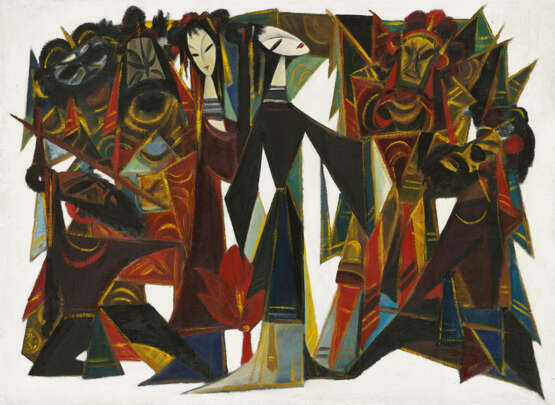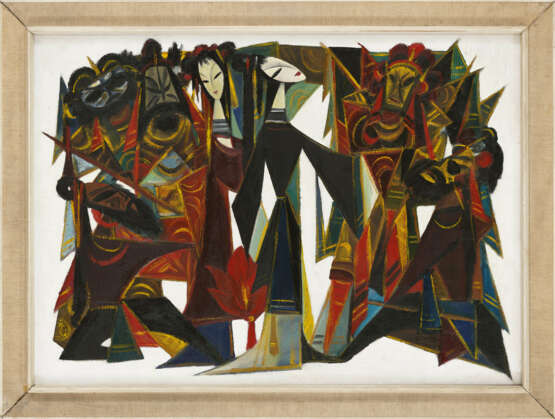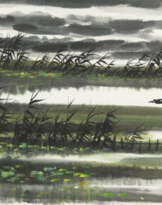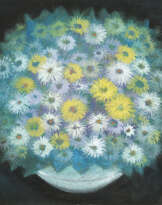ID 966057
Lot 1159 | LIN FENGMIAN (1900-1991)
Estimate value
HKD 4 500 000 – 6 500 000
Opera Figures: Lotus Lantern
Framed, oil on canvas
64 x 89 cm. (25 ¼ x 35 in.)
Signed by the artist
Provenance
Acquired directly from the artist by Mr John Molloy, the present owner, in Shanghai in 1962.
Post lot text
John Molloy was born in Doncaster, England, in 1938. Upon finishing school at Doncaster Grammar School in 1954, he took the British Civil Service entrance examination and joined the British Foreign Office the next year as a clerical staff. In 1957, Molloy joined the Royal Air Force for his national military service. During his service, he studied Chinese as a linguist and was stationed at the base in Siu Sai Wan, Hong Kong, between April 1958 and January 1959.
After his military service, Molloy resumed his career in the Foreign Office in London and was soon posted to the British Embassy in Kuwait. He served there from April 1959 until September 1960 and was then posted to China. Molloy arrived in Beijing in December 1960 and, in April 1961, began his position as British Vice Consul at the British Consulate General in Shanghai. He remained there until April 1963 before transferring to Düsseldorf in Germany.
Whilst in Shanghai, Molloy became good friends with Nien Cheng (1915-2009), the internationally renowned Chinese author of her autobiography Life and Death in Shanghai and friend of the artist Lin Fengmian. Cheng was born into a wealthy family in Beijing and studied at Yenching University and later the London School of Economics. After 1949, Nien Cheng’s husband, Kang-chi Cheng, served at the Shell Oil Company office in Shanghai until he died in 1957. Nien Cheng then joined the company as an adviser. During Molloy’s time in Shanghai, he frequently invited her to dinner parties he held. On one occasion, Cheng invited Molloy to dinner one evening at her house. This evening, Molloy noticed Lin Fengmian’s painting for the first time as he admired a painting on the wall of Cheng’s dining room. Taking notice of his interest, Cheng asked Molloy if he would like to meet the artist and a visit was arranged in the summer of 1962.
On the pre-arranged day of the visit, Molloy picked up Nien in his car and drove to Lin Fengmian’s home. Molloy recalls his visit, “he was very welcoming, and we sat down and chatted generally over tea. I knew our conversation would be being monitored, so it was of a very general nature, mostly about his life and career as an artist. I had been aware that the Chinese government used to sell his paintings in Hong. In return, they provided him with materials for his art. I was also aware that some of the foreign residents in Shanghai, most notably the two Shell managers who were there during my time, would also bring back materials for him whenever they went out of China on business or for holidays.
Towards the end of my stay at his home, which I think lasted about an hour, he invited Nien and me into his studio. It was full of paintings, both completed and in progress. I particularly admired the painting, which is now with you, and he explained its composition to me. I should say his English was excellent. When he saw how much I admired the painting, he very generously gave it to me. It was a rolled-up canvas at the time. “
Molloy took the Lin Fengmian painting with him when he left Shanghai in April 1963. The painting subsequently travelled with him to his next posting to Liberia, West Africa and then returned to England in October 1969, where he and the painting have been ever since.
In 1951, Lin Fengmian left Hangzhou for Shanghai, where he spent some fifteen peaceful years before the Cultural Revolution. On the advice of his close friend Guan Liang, Lin watched many operas during this period. He was inspired to create a series of paintings with blank backgrounds, based on famous titles: The Female Generals of the Yang Family, The Legend of the White Snake, Farewell My Concubine, and The Linked Rings. The present work, Opera Figures: Lotus Lantern, is considered a larger-scale piece in the series.
In Lotus Lantern the opera, the two lead female roles never appear on stage simultaneously, but in this composition, Lin arranged them together to express pure, motherly love. The background of the canvas is left blank so that the focus is entirely on the scene, where Erlang Shen is perhaps attempting to intervene in the impending marriage of Goddess San Sheng Mu and mortal Liu Yanchang. In the opera, the goddess drives the mortal away with the lotus lantern.
Lin’s characters’ costumes are dark: red, blue, and green. A bright and vibrant yellow is used to paint lines and small blocks between them. The female figures’ fair faces are the highlight of the painting. Their oval shapes contrast with the straight lines of the male characters. The menacing Erlang Shen and his fierce followers further accentuate the calm and composed nature of the two women.
Unlike Guan Liang, who is known for the simplicity and vivacity of his opera figures, Lin Fengmian focused on overlapping geometric shapes to convey continuity of time and space. At the opera, his sketchbook was always in-hand, collecting details for his compositions. He abstracted the details, creating conversations between Chinese painting and modern Western art that appealed to expats living in Shanghai.
| Artist: | Lin Fengmian (1900 - 1991) |
|---|---|
| Art style: | Modern art |
| Artist: | Lin Fengmian (1900 - 1991) |
|---|---|
| Art style: | Modern art |
| Address of auction |
CHRISTIE'S 18 Chater Road Central Hong Kong Hong Kong | ||||||||||||||
|---|---|---|---|---|---|---|---|---|---|---|---|---|---|---|---|
| Preview |
| ||||||||||||||
| Phone | +85227601766 | ||||||||||||||
| Fax | +852 2760 1767 | ||||||||||||||
| Conditions of purchase | Conditions of purchase | ||||||||||||||
| Business hours | Business hours
|












